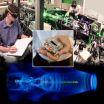(Press-News.org) Consumers are more likely to remember an ad they've seen repeatedly if one element in the ad changes location from one exposure to the next, according to a new study in the Journal of Consumer Research.
"Consumers are bombarded with thousands of advertisements daily, are increasingly multitasking, and are preoccupied with everyday activities. The likelihood that they will devote their full attention to any one specific message is getting smaller every day. What impact can an ad have if consumers pay virtually no attention to it?" write authors Stewart Shapiro (University of Delaware) and Jesper H. Nielsen (University of Arizona).
Even when consumers pay very limited attention, advertising can succeed through repetition. When consumers are exposed to a print ad, an image of the ad is stored in their memory and this image becomes clearer with each exposure to the ad. As this memory becomes clearer, preference for the ad increases. Notably, this occurs even if prior exposures to the ad are extremely brief and a consumer devotes much of their attention to something other than the ad.
In a series of experiments, the authors found that this effect may actually be enhanced if one ad element such as the brand logo or product depiction changes location within an ad from one exposure to the next. Under conditions of limited attention, making subtle changes to an ad over repeated exposures may in fact be better than repeating the exact same ad or altering more ad elements from one exposure to the next. For instance, a company could create a more effective ad by placing their brand logo in the bottom left corner the first time it is shown, and then placing it in the bottom right corner of the otherwise unchanged ad the next time it is shown.
"Companies are still learning how to make the most of advertisements that are viewed quickly as a consumer searches for something else on a web page or in a magazine. Subtle changes to ads viewed repeatedly can boost advertising effectiveness in increasingly cluttered environments visited by increasingly unfocused consumers," the authors conclude.
### Stewart Shapiro and Jesper H. Nielsen. "What the Blind Eye Sees: Incidental Change Detection as a Source of Perceptual Fluency." Journal of Consumer Research: April 2013. For more information, contact Stewart Shapiro (sshapiro@udel.edu) or visit http://ejcr.org/.
In the blink of an eye: Distracted consumers are most likely to remember ads with subtle variations
2012-10-22
ELSE PRESS RELEASES FROM THIS DATE:
Split-personality elliptical galaxy holds a hidden spiral
2012-10-22
Most big galaxies fit into one of two camps: pinwheel-shaped spiral galaxies and blobby elliptical galaxies. Spirals like the Milky Way are hip and happening places, with plenty of gas and dust to birth new stars. Ellipticals are like cosmic retirement villages, full of aging residents in the form of red giant stars. Now, astronomers have discovered that one well-known elliptical has a split personality. Centaurus A is hiding a gassy spiral in its center.
"No other elliptical galaxy is known to have spiral arms," said lead author Daniel Espada (National Astronomical Observatory ...
High quality or poor value: When do consumers make different conclusions about the same product?
2012-10-22
Depending on which naive theory consumers use, a low price can indicate either good value or low quality, whereas a high price may imply either poor value or high quality, according to a new study in the Journal of Consumer Research.
"Consumers rarely have complete information and use various strategies to fill the gaps in their knowledge as they consider and choose products. One of these strategies involves using naive theories: informal, common sense, explanations that consumers use to make sense of their environment. For example, consumers may believe that popular ...
Rewards programs: When do consumers compare experience over value?
2012-10-22
Consumers are often less satisfied when they buy or receive products that are easily counted because this makes them focus on value instead of experience, according to a new study in the Journal of Consumer Research.
"Numbers make us feel more certain of what is in front of us. When we count, we understand exactly how big, expensive, heavy, or old something is. But when we buy or receive products that are easily counted, we may be less satisfied," write authors Jingjing Ma and Neal J. Roese (both Kellogg School of Management, Northwestern University).
What happens when ...
Greater parental stress linked to children's obesity, fast food use and reduced physical activity
2012-10-22
Parents with a higher number of stressors in their lives are more likely to have obese children, according to a new study by pediatric researchers. Furthermore, when parents perceive themselves to be stressed, their children eat fast food more often, compared to children whose parents feel less stressed.
"Stress in parents may be an important risk factor for child obesity and related behaviors," said Elizabeth Prout-Parks, M.D., a physician nutrition specialist at The Children's Hospital of Philadelphia, who led a study published online today in the November issue of ...
Friendship 2.0: Teens' technology use promotes sense of belonging, identity
2012-10-22
With adolescents seemingly glued to cell phones and social networking websites, experts are investigating whether the near-constant digital activity changes youths' development.
A new study from the University of Washington shows that digital media helps teens reach developmental milestones, such as fostering a sense of belonging and sharing personal problems. But the study also raised questions about whether digital connectedness might hinder the development of an autonomous sense of self.
Katie Davis, an assistant professor in the Information School and an expert ...
Breast cancer cells enticed to spread by 'tumorous environment' as well as genetic changes
2012-10-22
A new study from Johns Hopkins researchers suggests that the lethal spread of breast cancer is as dependent on a tumor's protein-rich environment as on genetic changes inside tumor cells.
In a report in the Sept. 25 issue of the Proceedings of the National Academy of Sciences, the scientists conclude that a molecular signal in the protein meshwork surrounding the breast cancer cells may provide the critical trigger to initiate the life-threatening process of metastasis to distant sites in the body.
Moreover, their experiments suggest that the environment surrounding ...
Clue to cause of Alzheimer's dementia found in brain samples
2012-10-22
Researchers at Washington University School of Medicine in St. Louis have found a key difference in the brains of people with Alzheimer's disease and those who are cognitively normal but still have brain plaques that characterize this type of dementia.
"There is a very interesting group of people whose thinking and memory are normal, even late in life, yet their brains are full of amyloid beta plaques that appear to be identical to what's seen in Alzheimer's disease," says David L. Brody, MD, PhD, associate professor of neurology. "How this can occur is a tantalizing ...
State-of-the-art beams from table-top accelerators
2012-10-22
Focusing in on beam focus
The rapidly evolving technology of laser plasma accelerators (LPAs) – called "table-top accelerators" because their length can be measured in centimeters instead of kilometers – promises a new breed of machines, far less expensive and with far less impact on the land and the environment than today's conventional accelerators.
Future LPAs offer not only compact high-energy colliders for fundamental physics but diminutive light sources as well. These will probe chemical reactions, from artificial photosynthesis to "green catalysis"; unique biological ...
Scattered X-rays reveal diseased tissue
2012-10-22
This press release is available in German.
Chronic obstructive pulmonary disease (COPD) is considered the fourth most common cause of death in the United States. Usually the precursor to this life-threatening lung disease is a chronic bronchitis. Partially destroyed alveoli and an over-inflation of the lungs, known as emphysema, are serious side effects. However, the subtle differences in the tissue are barely discernable in standard X-ray images.
In addition to the conventional X-ray images, the Munich scientists analyzed the radiation scattered by the tissue. ...
Fewer patient deaths after surgery in hospitals known for good nursing care
2012-10-22
Patients treated in magnet hospitals (specially designated for their nursing excellence) had 14 percent lower odds of death than those in non-magnet hospitals in a four-state study of 564 hospitals led by the University of Pennsylvania School of Nursing. The magnet designation, determined by the American Nurses Credentialing Center, recognizes high-quality patient care, high levels of nurse education, and nursing innovation.
"Even controlling for differences in nursing, hospital, and patient characteristics, surgical patients fared better in magnet hospitals," said lead ...


